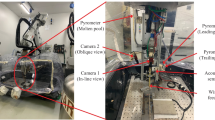Abstract
Laser cladding is a complex manufacturing process. As the laser beam melts the feedstock powder, small changes in laser power or traverse speed reflect on deviations of the deposition’s geometry. Thus, fine-tuning these process parameters is crucial to achieve desirable results. In order to monitor and further understand the laser cladding process, an automated method for clad bead final geometry estimation is proposed. To do so, six different convolutional neural network architectures were developed to analyze the process’ molten pool image acquired by a 50-fps coaxial camera. Those networks receive both the camera image and the process parameters as inputs, yielding width and height of the clad beads as outputs. The results of the network’s performances show testing error mean values as little as 8 μm for clad beads around a millimeter in height. For the width dimension, in 95% of the cases, the error remained under 15% of the bead’s width. Plots of the target versus the estimated values show coefficients of determination over 0.95 on the testing set. The architectures are then compared, and their performances are discussed. Deeper convolutional layers far exceeded the performance of shallower ones; nonetheless, deeper densely connected layers decreased the performances of the networks when compared with shallower ones. Those results represent yet another alternative on intelligent process monitoring with potential for real-time usage, taking the researches one step further into develo** a closed-loop control for this process.











Similar content being viewed by others
References
Meriaudeau F, Renier E (1996) Truchetet F CCD technology applied to laser cladding. In: Anagnostopoulos Constantine N, Blouke Morley M, Lesser Michael P (eds) Solid state sensor arrays and CCD cameras. CA, USA, San Jose, pp 299–309
Meriaudeau F, Truchetet F (1996) Image processing applied to the laser cladding process. Proc SPIE Int Soc Opt Eng 2789:93–103
Meriaudeau F, Truchetet F (1996) Control and optimization of the laser cladding process using matrix cameras and image processing. Journal of Laser Applications 8(6):317–324. https://doi.org/10.2351/1.4745438
Meriaudeau F, Truchetet F, Dumont C, Renier E, Bolland P Acquisition and image processing system able to optimize laser cladding process. In: Proceedings of the 1996 3rd International Conference on Signal Processing, ICSP‘96. Part 1 (of 2), Piscataway, NJ, United States, Bei**g, China, 1996. IEEE, pp 1628–1631
Hu D, Mei H, Kovacevic R (2002) Improving solid freeform fabrication by laser-based additive manufacturing. Proc Inst Mech Eng B J Eng Manuf 216(9):1253–1264. https://doi.org/10.1243/095440502760291808
Hu D, Kovacevic R (2003) Modelling and measuring the thermal behaviour of the molten pool in closed-loop controlled laser-based additive manufacturing. Proc Inst Mech Eng B J Eng Manuf 217(4):441–452. https://doi.org/10.1243/095440503321628125
Toyserkani E, Khajepour A (2006) A mechatronics approach to laser powder deposition process. Mechatronics 16(10):631–641. https://doi.org/10.1016/j.mechatronics.2006.05.002
**ng F, Liu W, Wang T Real-time sensing and control of metal powder laser forming. In: 6th World Congress on Intelligent Control and Automation, WCICA 2006, Dalian, 2006. pp 6661–6665. doi:https://doi.org/10.1109/WCICA.2006.1714372
Hofman JT, De Lange DF, Meijer J Camera based feedback control of the laser cladding process. In: ICALEO 2006 - 25th International Congress on Applications of Laser and Electro-Optics, Scottsdale, AZ, 2006
Lei J, Wang Z, Liu L (2010) Design of forming shape measurement system for laser molten pool in laser fabricating. International Conference on Engineering Design and Optimization, ICEDO 2010, vol 37–38. Ningbo. doi:https://doi.org/10.4028/www.scientific.net/AMM.37-38.327
Arias JL, Montealegre MA, Vidal F, Rodríguez J, Mann S, Abels P, Motmans F Real-time laser cladding control with variable spot size. In: Laser 3D Manufacturing, San Francisco, CA, 2014. SPIE. doi:https://doi.org/10.1117/12.2040058
Ocylok S, Alexeev E, Mann S, Weisheit A, Wissenbach K, Kelbassa I Correlations of melt pool geometry and process parameters during laser metal deposition by coaxial process monitoring. In: Schmidt M, Merklein M, Vollertsen F (eds) International Conference on Laser Assisted Net Shape Engineering, LANE 2014, 2014. Elsevier B.V., pp 228–238. doi:https://doi.org/10.1016/j.phpro.2014.08.167
Moralejo S, Penaranda X, Nieto S, Barrios A, Arrizubieta I, Tabernero I, Figueras J (2017) A feedforward controller for tuning laser cladding melt pool geometry in real time. Int J Adv Manuf Technol 89(1–4):821–831. https://doi.org/10.1007/s00170-016-9138-7
Iravani-Tabrizipour M, Toyserkani E (2007) An image-based feature tracking algorithm for real-time measurement of clad height. Mach Vis Appl 18(6):343–354. https://doi.org/10.1007/s00138-006-0066-7
Iravani-Tabrizipour M, Asselin M, Toyserkani E Development of an image-based feature tracking algorithm for real-time clad height detection. In: 4th IFAC Symposium on Mechatronic Systems, MX 2006, Heidelberg, 2006. pp 914–920
Mondal S, Bandyopadhyay A, Pal PK An experimental investigation into the optimal processing conditions for the co2 laser cladding of 20 MnCr5 steel using taguchi method and ANN. In: International Conference on Modeling, Optimization, and Computing, ICMOC 2010, Durgapur, West Bengal, 2010. pp 392–398. doi:https://doi.org/10.1063/1.3516337
Aggarwal K, Urbanic RJ, Saqib SM (2018) Development of predictive models for effective process parameter selection for single and overlap** laser clad bead geometry. Rapid Prototy** J 24(1):214–228. https://doi.org/10.1108/RPJ-04-2016-0059
Caiazzo F, Caggiano A (2018) Laser direct metal deposition of 2024 al alloy: trace geometry prediction via machine learning. Mater 11(3). https://doi.org/10.3390/ma11030444
Huaming LX, Qin; Song, Huang; Lei, **; Yongliang, Wang; Kaiyun, Lei (2018) Geometry characteristics prediction of single track cladding deposited by high power diode laser based on genetic algorithm and neural network. Int J Precis Eng Manuf 19 (7):1061–1070. doi:https://doi.org/10.1007/s12541-018-0126-8
Barua S, Sparks T, Liou F (2011) Development of low-cost imaging system for laser metal deposition processes. Rapid Prototy** J 17(3):203–210. https://doi.org/10.1108/13552541111124789
Davis TA, Shin YC (2011) Vision-based clad height measurement. Mach Vision Appl 22(1):129–136. https://doi.org/10.1007/s00138-009-0240-9
Liu J, Wu Y, Wang L In-situ measurement based on prior calibration with analogist samples for laser cladding. In: High-Power Lasers and Applications VI, November 5, 2012 - November 5, 2012, Bei**g, China, 2012. Proceedings of SPIE - The International Society for Optical Engineering. SPIE, pp The Society of Photo-Optical Instrumentation Engineers (SPIE); Chinese Optical Society (COS). doi:https://doi.org/10.1117/12.2000253
Doubenskaia M, Pavlov M, Grigoriev S, Smurov I (2013) Definition of brightness temperature and restoration of true temperature in laser cladding using infrared camera. Surf Coat Technol 220:244–247. https://doi.org/10.1016/j.surfcoat.2012.10.044
Acknowledgments
The authors would like to thank the Laboratório de Mecânica de Precisão (Precision Mechanics Laboratory) staff for making this work possible. They would also like to thank the Labmetro for the hardware support.
Funding
The authors would like to thank the Conselho Nacional de Desenvolvimento Científico e Tecnológico (CNPq) for funding this work.
Author information
Authors and Affiliations
Corresponding author
Ethics declarations
Competing interests
The authors declare that they have no conflict of interest.
Additional information
Publisher’s note
Springer Nature remains neutral with regard to jurisdictional claims in published maps and institutional affiliations.
Rights and permissions
About this article
Cite this article
Gonçalves, D.A., Stemmer, M.R. & Pereira, M. A convolutional neural network approach on bead geometry estimation for a laser cladding system. Int J Adv Manuf Technol 106, 1811–1821 (2020). https://doi.org/10.1007/s00170-019-04669-z
Received:
Accepted:
Published:
Issue Date:
DOI: https://doi.org/10.1007/s00170-019-04669-z




